I have found the ideal antidote to having your in-laws over for the holidays. A golf trip to the southern hemisphere works wonders for both parties. In what can only be described as an ideal situation I was able to go to South Africa while my in-laws were staying at my house.
Travel to South Africa
I have previously written that getting to Royal Dornoch and Sand Hills was difficult. Well, my latest experience, golf in sub-Saharan Africa, takes the travel experience to an unprecedented level. The Durban Country Club (ranked #70 in the world) is located in the South African province of KwaZulu-Natal. This area of South Africa, now called The Zulu Kingdom, formerly known as The Zululand, took me more than 24 hours to get to once I left my house. I took back to back red-eyes with a change of planes in London. I arrived in Gatwick, then took the Gatwick Express to Victoria Station, took one of the world's great remaining institutions, the London taxi, to Paddington Station for the trip to Heathrow. As you already know I love all things British. I opted for British Airways instead of a direct flight from New York because I was told that the plane stops in West Africa and can be a bit dicey, plus this itinerary allowed me to bypass Johannesburg in favor of Cape Town. Also, the direct route is eighteen straight hours, and stopping in London allowed me to break the trip up a bit, although terminal four at Heathrow is a poorly designed corrugated-tin disaster.

I also forgot how much better a wide-body jet is than a narrow-body. I fly a lot on 737s and regional jets and it was nice to have a two-tiered 747 with a more open feeling. Our flight flew over the continent of Africa all night and there can't be a much better view from the air than approaching Cape Town with the sun rising on a new day. You get a full panoramic view of the ocean, the city and Tabletop Mountain behind the city, which is both larger than it looks in pictures and closer to the city and water. It is a soul-stirring scene.

Cape Town - worth the long flight
Durban
Finally, a two hour flight to Durban on South African Airways and I was there. Durban is Africa's largest and busiest port city and also is a beach resort that reminded me of a cross between Miami and Mumbai. Picture it as 1950s South Beach with saris instead of bikinis and you get the idea. A sub-tropical city, Durban grew rapidly in the late 19th and early 20th centuries when its main industry, sugar cane, was booming. Many laborers from India were imported to South Africa during this period as indentured servants. Remnants of this historical period remain within the fabric of Durban today. The city still has a very large Indian population, the largest Indian population center outside of India. The city remains a major working port and is still a center for sugar. As you drive in from the airport the road is lined with warehouses, sugar processing plants and grain elevators. Durban is a much different city than the more polished and cosmopolitan Cape Town.
Durban Country Club
Durban Country Club has several unique aspects among the top 100 golf courses in the world. It is the only course on the Indian Ocean, the only on the continent of Africa and the course located closest to the Tropic of Capricorn. The course is located ten minutes from the city center between a rugby stadium and the Indian Ocean. The Durban Country Club was shaped from the bush and dunes of the KwaZulu-Natal coast during the early 1920s by a local golf professional George Waterman and Laurie Waters. Colonel S.V. Hotchkin who also worked extensively on one of my favorite courses in England, Woodhall Spa, made changes to Durban in 1928 and these are evident when you play this gem of a course. Additional changes were made by Bob Grimsdell in 1959.
Finally, a two hour flight to Durban on South African Airways and I was there. Durban is Africa's largest and busiest port city and also is a beach resort that reminded me of a cross between Miami and Mumbai. Picture it as 1950s South Beach with saris instead of bikinis and you get the idea. A sub-tropical city, Durban grew rapidly in the late 19th and early 20th centuries when its main industry, sugar cane, was booming. Many laborers from India were imported to South Africa during this period as indentured servants. Remnants of this historical period remain within the fabric of Durban today. The city still has a very large Indian population, the largest Indian population center outside of India. The city remains a major working port and is still a center for sugar. As you drive in from the airport the road is lined with warehouses, sugar processing plants and grain elevators. Durban is a much different city than the more polished and cosmopolitan Cape Town.
Durban Country Club
Durban Country Club has several unique aspects among the top 100 golf courses in the world. It is the only course on the Indian Ocean, the only on the continent of Africa and the course located closest to the Tropic of Capricorn. The course is located ten minutes from the city center between a rugby stadium and the Indian Ocean. The Durban Country Club was shaped from the bush and dunes of the KwaZulu-Natal coast during the early 1920s by a local golf professional George Waterman and Laurie Waters. Colonel S.V. Hotchkin who also worked extensively on one of my favorite courses in England, Woodhall Spa, made changes to Durban in 1928 and these are evident when you play this gem of a course. Additional changes were made by Bob Grimsdell in 1959.

In vestiges of its British colonial heritage, local rules at Durban indicate what to do should balls inadvertently come to rest on one of the two grass bowling greens.
The Golf Course
I liked Durban Country Club as a golf course, although it does not have 18 strong holes. It has a particularly strong start, especially the first five holes that are narrow, hilly holes that play in the bush. The middle holes, 9-15 are average at best, but the course has a strong finish with the last three holes. The front nine are near the Indian Ocean and thus are more impacted by the wind. The course is not directly on the ocean; there is a busy and loud highway that runs between the course and the ocean. On the first day I played there were many windsurfers and parasailers out on the water enjoying the strong wind, which usually isn't a good sign for golf, but it turned out ok. The back nine is away from the water and not as impacted by the wind. The massive Durban Stadium towers over a couple of holes on the back nine.
So how is it that a course with seven average holes wedged between two concrete structures is ranked in the world's top 100? The answer is because the good holes are so good that they more than compensate for the weak holes. Plus, the attraction of playing in the bush really makes it unique.
Rough/bush at Durban Country Club 1st hole
One of the defining characteristics of Durban Country Club are the massive undulations in the fairways, especially the 5th, 8th and 17th. The course was built on sand dunes and they are large and interesting. At Durban, you don't have trouble in the traditional sense we find it in the U.S. or British Isles. Off many of the fairways is thick sub-tropical vegetation. This bush is pretty much unplayable if your ball goes in it.
View from the second tee box
The par five third hole is one of the best in the world I have had the privilege to play. It has a high elevated tee with a view of the Indian Ocean. You hit down a narrow valley surrounded on both sides by thick bush. When you are down in the fairway you can't hear any external noise, including the ocean or the highway. You can hear the wildlife and birds chirping away, though. I saw several exotic birds, including the brilliant black and red scarlet-chested sunbirds flying back and forth between the trees on this hole. This hole and its environs are a miniature bird sanctuary. The wildlife here is so rich that the Country Club allows visiting bird watchers to tour the course when they want.
Once you putt out from the elevated green on this hole you walk through a path in the bush to climb to the next tee box. This same scene is repeated on the next tee to green walk as well.
Once you putt out from the elevated green on this hole you walk through a path in the bush to climb to the next tee box. This same scene is repeated on the next tee to green walk as well.
Durban's world class third hole - Par 5 in the bush
Durban is a shot makers course that you have to think your way around. My caddie didn't hand me a driver until the 8th tee due to the narrowness of the opening holes.
The 8th hole is a very good par five that requires a long and straight drive. The hole then turns sharply to the left and the approach to the green is uphill and to the right. The beauty of the hole is that unless you are on the far right side of the hole, you have no shot at the green. After your drive, the hole requires back-to-back well struck short iron shots over two large dunes to an elevated green.
The 8th hole is a very good par five that requires a long and straight drive. The hole then turns sharply to the left and the approach to the green is uphill and to the right. The beauty of the hole is that unless you are on the far right side of the hole, you have no shot at the green. After your drive, the hole requires back-to-back well struck short iron shots over two large dunes to an elevated green.
12th hole par 3 - "Prince of Wales" hole
There is a half-way house with seating between the 9th and 10th tees. The custom at Durban is to stop at the halfway house and have some beverages and food, which every group did both days I was there. Since you are in the tropics, the need to cool down and take a break from the heat and humidity trumps the need to keep playing and complete a round quickly.
The 12th hole, pictured above, caused Edward, His Royal Highness, the Prince of Wales to card a 16. In return, for posting his score honestly, he was rewarded with his name on the hole in infamy.
While playing the 16th hole, I experienced a uniquely Durbanesque experience. I hit my tee shot into the left rough on this par four, near the bush and under a tree. As I walked over to assess my lie a monkey dropped from the tree, to look both me and the ball over. The look on his face (captured below), tells me he wasn't particularly impressed with my tee shot. He sat nearby and watched me hit my second shot fat, or as my caddy said in the local parlance, "it was a rank shot". In my defense, it is hard to concentrate with a monkey as your gallery. I ended up making a double bogey, or as it is called in South Africa a "double drop".

My gallery at Durban about to watch a "rank" shot
The 17th, pictured below, is a particularly good example of how wild and crazy the undulations are at Durban. 17th hole approach to the green
I drove the 270 yard par four 18th hole (below) with a three wood. The feat actually wasn't that impressive since the hole played downwind, which is the prevailing wind. It seems like a good risk-reward hole for match play since pulling the ball would leave you in the bush and slicing it runs the ball down a steep bank toward the practice range. Along with Prestwick and North Berwick it is among the shortest finishing holes anywhere in championship golf. Personally, I would change it to a par three and make the course a par 71. It would make one hell of a par three. The finishing hole has yielded eighteen holes-in-one according to the plaque in the clubhouse.
I was quite proud to have played the same ball at Durban for all 18 holes. I kept my ball in play with irons off many tees and did not lose any in the bush.
I was quite proud to have played the same ball at Durban for all 18 holes. I kept my ball in play with irons off many tees and did not lose any in the bush.

18th hole looking back from the green
My caddie the first day at Durban didn't wear shoes, as many of them here do not. They carry your bag around bare foot. There is also no automated ball machine at The Durban Country Club driving range. On the narrow range, you hit balls and a caddie stands in the range and picks up and cleans each ball as you hit them. Durban is a unique golf course and the course was in exceptionally good condition when I played there, especially the umgeni grass greens.
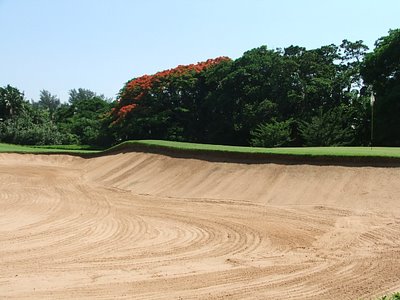
Bunkering on the 7th hole
Sewsunker "Papwa" Sewgolum
One of the unexpected things I am finding on this quest is some of the lost stories in the history of golf that I have stumbled across. Sewsunker Sewgolum, whose nickname was Papwa, is one of them. In 1963, Sewsunker, a 5-foot-4-inch, 150 pound caddie and self-taught golfer of Indian descent became the first non-white to compete in a white only tournament in South Africa, the Natal Open, played at the Durban Country Club. He had the temerity to actually win the tournament, beating a field of 113 white golfers. During the awards ceremony, Sewsunker was presented the trophy in the pouring rain while the white club membership was snug inside the clubhouse watching in dry splendor. The white runners-up were awarded their prizes in the clubhouse. Sewsunker played and won under great adversity. He took his meals during the tournament with the black caddies and had to change his clothes in a car. The South African Broadcasting Corporation, which was government owned at the time, cancelled coverage of the tournament once Papwa entered and did not report the results on its news program. All this occurred at the height of the apartheid period in South African history. When the picture showing Sewsunker receiving the trophy in the rain (image below) was shown around the world it caused an outrage and put pressure on the South African government to change its apartheid policies.
One of the unexpected things I am finding on this quest is some of the lost stories in the history of golf that I have stumbled across. Sewsunker Sewgolum, whose nickname was Papwa, is one of them. In 1963, Sewsunker, a 5-foot-4-inch, 150 pound caddie and self-taught golfer of Indian descent became the first non-white to compete in a white only tournament in South Africa, the Natal Open, played at the Durban Country Club. He had the temerity to actually win the tournament, beating a field of 113 white golfers. During the awards ceremony, Sewsunker was presented the trophy in the pouring rain while the white club membership was snug inside the clubhouse watching in dry splendor. The white runners-up were awarded their prizes in the clubhouse. Sewsunker played and won under great adversity. He took his meals during the tournament with the black caddies and had to change his clothes in a car. The South African Broadcasting Corporation, which was government owned at the time, cancelled coverage of the tournament once Papwa entered and did not report the results on its news program. All this occurred at the height of the apartheid period in South African history. When the picture showing Sewsunker receiving the trophy in the rain (image below) was shown around the world it caused an outrage and put pressure on the South African government to change its apartheid policies.
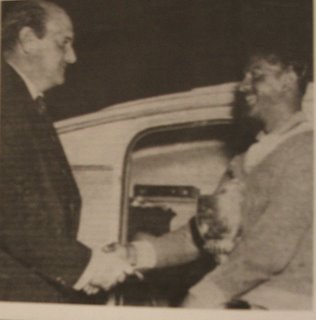
The Durban Country Club's 1982 club history includes a comical explanation of why he was slighted - The laws of the day were such that Indian people were not allowed inside the clubhouse. An infraction of those laws could have resulted in the club losing its liquor license and being closed down. They also state that if they had moved the ceremony inside Sewsunker's fans wouldn't have been able to see him receive the trophy. To quote, "It certainly was not a slight to Papwa - rather one of consideration to enable his fans to see him in his moment of victory." I don't know, does that sound like consideration to you?
In 1965, in the same tournament, Sewsunker played again and won, beating Gary Player, who won the US Open in that same year. Unfortunately his success was short lived - the following year he was banned from all local tournaments and the apartheid government withdrew his passport, preventing him from playing internationally. He could not even enter courses as a spectator. Prior to banning him, Sewsunker played in the South African PGA tournament while two Government agents followed him around the course to make sure that segregation laws were enforced. Under the laws at the time, non-whites could play only among themselves before spectators who were also non-white. The crowds at the tournament were segregated. During this period, security police regularly followed him around and harassed and threatened him frequently. He had to apply for permits to play in white tournaments and sometimes they were granted but often times they were not.
In another highly offense remark in the club history they say, "Sadly, brilliant golfer that he was, Papwa seemed to lack the determination and discipline to remain at the top." What an absolutely disgraceful statement. Ban the poor guy from playing and then say he lacked the will to play?
Prior to the ban, Sewsunker competed internationally with great success. While he was not caddying, Sewgolum worked in an Oil of Olay factory putting the tops onto filled bottles. He was befriended by the founder and owner of Oil of Olay who took him to Europe to play. Prior to his going on the first trip in 1959, however, they had to teach him how to write his name so that he could sign his scorecards, since he was illiterate. They also had to teach him how to use a knife and fork since previously he had only eaten with his hands. Before he was banned, Sewgolum won the Dutch Open championship in 1959, 1960 & 1963. He played in the British Open Championship a handful of times including at Muirfield in 1959 and Royal Lytham in 1963, where he made the cut. He shot 71 in the first round, the same as Jack Nicklaus. Through 36 holes he was tied with Gary Player and two strokes ahead of Arnold Palmer.
What makes Sewsunker's story even more amazing is that he played the game with a back-handed grip, hands positioned the opposite way to the traditional grip. The unorthodox grip is now known as the Sewsunker grip - named after Sewgolum because he used it with such success. Imagine for a minute a back-handed grip or kack-handed grip as it is also sometimes called. How is it even possible? The game is hard enough, could you imagine holding the club wrong, with your left hand beneath your right?
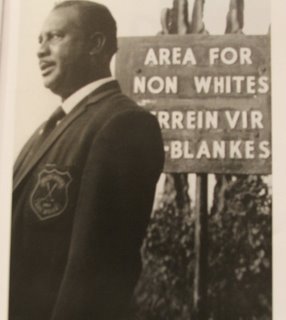
There are those that would prefer we only recount the great history of the game and let incidents like this fade away, but I think stories like these are worth re-telling. I offer no apologies to those that think I am besmirching golf and its reputation. Unfortunately, golf has had a history of excluding people of race, and while not a proud chapter at many of the country clubs on the top 100 list, it is a chapter none-the-less. Stories like this also remind me that what golfers like Lee Elder and Tiger Woods have been able to accomplish are all the more impressive given the history of segregation and apartheid.
To their credit, The Durban Country Club recently honored Sewgolum, creating a memorial plaque in honor of him, unveiled in 2005. Club Chairman Ray Lalouette described the 1963 Natal Open awards ceremony as, "an ignominious debacle that must have been the source of much embarrassment and humiliation for a fellow human being at a time when he should have been experiencing joby and jubilation."
"No matter what the background, or the rules of the land, it must have been an experience that caused hurt and shame for him and his family."
"It is therefore fitting and appropriate that I, as the current chairman, take this opportunity on behalf of the members of The Durban Country Club, to apologize to Mrs Suminthra Sewgolum and to Mr Sewgolum's Son, Rajen, and his family for the suffering you have endured as a result of that most unfortunate incident."
"We have commissioned this plaque to serve as a permanent reminder to all those (and especially golfers) who walk this way, that 'Papwa' Sewgolum was a remarkable man."
Remarkable indeed. Good recovery on the part of Durban Country Club, in my view.
South Africa
In a sign of full progress, I played on the first day at Durban with an Indian member who was proud to show off his course and he was a delight. He bought me several beers afterward and even drove me back to the Royal Hotel where I was staying. If your travels ever take you to this fascinating continent, I recommend visiting Durban Country Club, to experience this unique golf course and to honor the memory of Papwa Sewgolum.
Although a former British colony and Western by many standards, Durban at times feels very African. There are lots of white mini-vans plying up and down the streets with music blaring and each is packed with people. Designed to carry at most ten people, they usually had about twenty people packed in. They stop every few blocks and serve as local taxis. They make the city chaotic since they seem to stop and start at will. There are also still vestiges of apartheid present - blacks and whites still don't mingle and there are strong undertones present; wherever you go you notice race. An afrikaner cab driver I had was ranting against the ANC, now the ruling party, about how they have ruined the country. On the other side, my caddie praised the ANC for restoring equality and moving the country in the right direction.
 The rugby stadium from the back nine
The rugby stadium from the back nine Several people including the hotel staff and members of the club told me to be careful, that parts of the city are quite dangerous. At times, it was a bit uncomfortable, but honestly, no more so than in certain parts of Los Angeles, New York or Miami. I did note that parts of the golf course were discretely surrounded by barbed wire around the perimeter. Parts of Durban are seedy and raffish, but it's the real world my friends. It helps me to broaden my perspective to get outside my comfort zone every now and again and visit cities such as Durban.
Playing at Durban is something I will never forget. Playing the world's top courses sometimes gives you a myopic view of the world since you get to visit some of the world's most beautiful and premier locations. In an eye-opening experience, on the drive from Cape Town airport to the city center, you drive past the second largest "township" in South Africa after Soweto. The tiny, hand-made shacks that make up the township look unfit for human habitation. Their scale and magnitude is hard to take in, they go on for miles and are tightly clustered in a very high density. South Africa is a land of extremes that is hard to convey in words or pictures; the extreme beauty juxtaposed with the crushing povery. The great wealth and natural resources opposite such large scale suffering.
A Strong Finish
During my trip I never quite figured out the local currency, the South African rand. The exchange rate is obscenely good, however. I ate breakfast for US$2 and the golf was only US$60 including rental clubs. A very good bottle of wine at a vineyard in South Africa is US$10.
Like Ben Crenshaw at the 1999 Ryder Cup, I am a believer in fate. In what I take as a good omen for my quest, I bumped into Nobel Peace Prize winner Archbishop Desmond Tutu coming out of the lavatory on my flight back from Cape Town to London. Although my hair was sticking straight up after ten hours in a coach seat, he gave me a big smile and a friendly hello.
By the way, my little in-law experiment worked out so well that I'm already planning another trip to the Southern Hemisphere for the next holiday season, this time perhaps a trip down under to play in Tasmania?
Playing at Durban is something I will never forget. Playing the world's top courses sometimes gives you a myopic view of the world since you get to visit some of the world's most beautiful and premier locations. In an eye-opening experience, on the drive from Cape Town airport to the city center, you drive past the second largest "township" in South Africa after Soweto. The tiny, hand-made shacks that make up the township look unfit for human habitation. Their scale and magnitude is hard to take in, they go on for miles and are tightly clustered in a very high density. South Africa is a land of extremes that is hard to convey in words or pictures; the extreme beauty juxtaposed with the crushing povery. The great wealth and natural resources opposite such large scale suffering.
A Strong Finish
During my trip I never quite figured out the local currency, the South African rand. The exchange rate is obscenely good, however. I ate breakfast for US$2 and the golf was only US$60 including rental clubs. A very good bottle of wine at a vineyard in South Africa is US$10.
Like Ben Crenshaw at the 1999 Ryder Cup, I am a believer in fate. In what I take as a good omen for my quest, I bumped into Nobel Peace Prize winner Archbishop Desmond Tutu coming out of the lavatory on my flight back from Cape Town to London. Although my hair was sticking straight up after ten hours in a coach seat, he gave me a big smile and a friendly hello.
By the way, my little in-law experiment worked out so well that I'm already planning another trip to the Southern Hemisphere for the next holiday season, this time perhaps a trip down under to play in Tasmania?
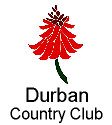
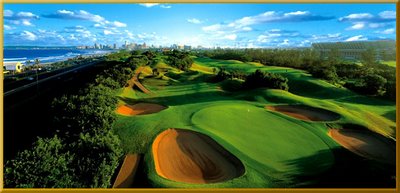
Tidak ada komentar:
Posting Komentar